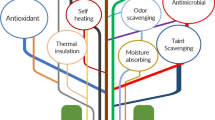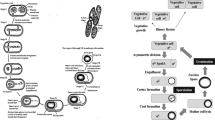Abstract
Purpose
This study investigated physicochemical properties and antimicrobial performance of soaps formulated from natural ingredients with the intention to apply them as alternative deodorizing soaps in personal care products.
Methods
Soaps were formulated with natural ingredients including lemon, aloe vera and honey. Foam stability and capacity tests as well as pH were determined for the soaps. Deodorizing effectiveness of the soaps was tested theoretically using minimum inhibitory concentration (MIC) test by screening them against pathogenic organisms causing body odour: bacteria (Staphylococcus aureus, Candida albican, Staphylococcus hominis, Strephotococcus mutant, Staphylococcus epidemidis) and fungi (Tinnea annum, Tinneapedis and Trycrophyton rubrum) using agar well diffusion method and poisoned food technique respectively while having Dettol soap and ketoconazole as controls.
Results
The soaps had a maximum foam capacity of 150% and foam stability of 100% with pH values in the range of 9.3–9.8 and inhibited the growth of the tested organisms for up to 6 days at 0.1 g/ml concentration.
Conclusion
The soaps are mildly alkaline, possess good foaming capacity and stability and have considerably significant antimicrobial properties that can impede the growth of the organisms.





Similar content being viewed by others
Data availability statement
All data generated and analysed during this study are included in this published article.
References
Laden K (1999) Antiperspirants and deodorants. CRC Press, Boca Raton
Barzantny H, Brune I, Tauch A (2012) Molecular basis of human body odour formation: insights deduced from corynebacterial genome sequences. Int J Cosmet Sci 34(1):2–11
Oliveira ECVD et al (2021) Deodorants and antiperspirants: identification of new strategies and perspectives to prevent and control malodor and sweat of the body. Int J Dermatol 60(5):613–619
Bhattacharjee G, Mitra K (2020) Comparative study on safety knowledge of deodrant/antiperspirant among college students. Am J Phys Sci Appl 1(2):12–15
Abbas SZ et al (2016) Anti-bacterial activity of different soaps available in local market of Rawalpindi (Pakistan) against daily encountered Bacteria. Pharm Anal Acta 7(11):522
Riaz S, Ahmad A, Hasnain S (2009) Antibacterial activity of soaps against daily encountered bacteria. Afr J Biotechnol 8(8):1431–1436
Mahmud S et al (2009) Volatile components, antioxidant and antimicrobial activity of Citrus acida var. sour lime peel oil. J Saudi Chem Soc 13(2):195–198
Feily A, Namazi MR (2009) Aloe vera in dermatology: a brief review. Giornale Ital Dermatol Venereol Organo Ufficiale Soc Ital Dermatol Sifilogr 144(1):85–91
Szweda P (2017) Antimicrobial activity of honey. Honey Anal 3:15
Basualdo C et al (2007) Comparison of the antibacterial activity of honey from different provenance against bacteria usually isolated from skin wounds. Vet Microbiol 124(3):375–381
Burlando B, Cornara L (2013) Honey in dermatology and skin care: a review. J Cosmet Dermatol 12(4):306–313
Farombi EO, Ige OO (2007) Hypolipidemic and antioxidant effects of ethanolic extract from dried calyx of Hibiscus sabdariffa in alloxan-induced diabetic rats. Fundam Clin Pharmacol 21(6):601–609
Polefka TG, Bianchini RJ, Shapiro S (2012) Interaction of mineral salts with the skin: a literature survey. Int J Cosmet Sci 34(5):416–423
Kuster W (2006) Ichthyoses: suggestions for an improved therapy. Deutsches Arzteblatt-Koln- 103(24):1389
Milstone LM (2010) Scaly skin and bath pH: rediscovering baking soda. J Am Acad Dermatol 62(5):885–886
Ogunjobi JK et al (2021) A class of surfactants via PEG modification of the oleate moiety of lactonic sophorolipids: synthesis, characterisation and application. Green Chem 23(24):9906–9915
Mohana DC, Raveesha KA (2007) Anti-fungal evaluation of some plant extracts against some plant pathogenic field and storage fungi. J Agric Technol 4(1):119–137
Codex Alimentarius C (2005) Codex standard for named vegetable oils (CODEX-STAN 210–1999). FAO/WHO, Rome
Félix S et al (2017) Soap production: a green prospective. Waste Manage 66:190–195
Elshafie HS et al (2015) In vivo antifungal activity of two essential oils from Mediterranean plants against postharvest brown rot disease of peach fruit. Ind Crops Prod 66:11–15
Fei P et al (2018) Antimicrobial activity and mechanism of action of olive oil polyphenols extract against Cronobacter sakazakii. Food Control 94:289–294
Shino B et al (2016) Comparison of antimicrobial activity of chlorhexidine, coconut oil, probiotics, and ketoconazole on Candida albicans isolated in children with early childhood caries: an in vitro study. Scientifica 2016:7061587
George ED, Raymond DJ (2016) Formulation of traditional soap cleansing systems. Soap manufacturing technology. Elsevier, pp 55–72
Goyal N, Jerold F (2021) Biocosmetics: technological advances and future outlook. Environ Sci Pollut Res. https://doi.org/10.1007/s11356-021-17567-3
Attaullah A et al (2021) Formulation of herbal soap against acne causing bacteria. Asian J Biol Life Sci 10(3):609
Atolani O et al (2016) Green synthesis and characterisation of natural antiseptic soaps from the oils of underutilised tropical seed. Sustain Chem Pharm 4:32–39
Tarun J et al (2014) Evaluation of pH of bathing soaps and shampoos for skin and hair care. Indian J Dermatol 59(5):442
Adjei F et al (2022) Formulation of mosquito repellent soap using neem extract, and Musa paradisiaca covers as a substitute source of alkalis. Case Stud Chem Environ Eng 5:100171
Johnson SA et al (2002) Comparative susceptibility of resident and transient hand bacteria to para-chloro-meta-xylenol and triclosan. J Appl Microbiol 93(2):336–344
Sickbert-Bennett EE et al (2004) The effects of test variables on the efficacy of hand hygiene agents. Am J Infect Control 32(2):69–83
Kiatwarawut K, Rokaya D, Sirisoontorn I (2022) Antimicrobial activity of various disinfectants to clean thermoplastic polymeric appliances in orthodontics. Polymers 14:2256. https://doi.org/10.3390/polym14112256
Kayaputri IL et al (2020) The antimicrobial effectiveness of cacao shell and cacao husk combination on inhibition of pathogenic bacteria in food products. IOP Conf Ser Earth Environ Sci 443(1):012077
Funding
There was no fund received for this study.
Author information
Authors and Affiliations
Contributions
OTA—investigation, data analyses and writing. JKO—conceptualization, data analyses, imaging, writing and editing.
Corresponding author
Ethics declarations
Conflict of interest
Authors declare no conflict of interests.
Rights and permissions
Springer Nature or its licensor (e.g. a society or other partner) holds exclusive rights to this article under a publishing agreement with the author(s) or other rightsholder(s); author self-archiving of the accepted manuscript version of this article is solely governed by the terms of such publishing agreement and applicable law.
About this article
Cite this article
Ogunjobi, J.K., Ademola, O.T. In Pursuit of Alternative Bio-based Body Deodorants: Production, Physicochemical and Antimicrobial Performances of Deodourising Soaps. Chemistry Africa 6, 1051–1059 (2023). https://doi.org/10.1007/s42250-022-00552-9
Received:
Accepted:
Published:
Issue Date:
DOI: https://doi.org/10.1007/s42250-022-00552-9




